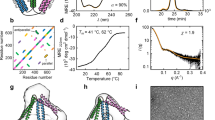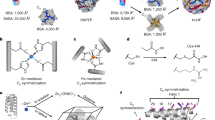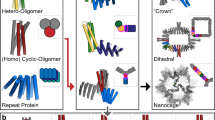Abstract
Protein structures evolved through a complex interplay of cooperative interactions, and it is still very challenging to design new protein folds de novo. Here we present a strategy to design self-assembling polypeptide nanostructured polyhedra based on modularization using orthogonal dimerizing segments. We designed and experimentally demonstrated the formation of the tetrahedron that self-assembles from a single polypeptide chain comprising 12 concatenated coiled coil–forming segments separated by flexible peptide hinges. The path of the polypeptide chain is guided by a defined order of segments that traverse each of the six edges of the tetrahedron exactly twice, forming coiled-coil dimers with their corresponding partners. The coincidence of the polypeptide termini in the same vertex is demonstrated by reconstituting a split fluorescent protein in the polypeptide with the correct tetrahedral topology. Polypeptides with a deleted or scrambled segment order fail to self-assemble correctly. This design platform provides a foundation for constructing new topological polypeptide folds based on the set of orthogonal interacting polypeptide segments.
This is a preview of subscription content, access via your institution
Access options
Subscribe to this journal
Receive 12 print issues and online access
$259.00 per year
only $21.58 per issue
Buy this article
- Purchase on Springer Link
- Instant access to full article PDF
Prices may be subject to local taxes which are calculated during checkout




Similar content being viewed by others
References
Chen, J.H. & Seeman, N.C. Synthesis from DNA of a molecule with the connectivity of a cube. Nature 350, 631–633 (1991).
Rothemund, P.W. Folding DNA to create nanoscale shapes and patterns. Nature 440, 297–302 (2006).
He, Y. et al. Hierarchical self-assembly of DNA into symmetric supramolecular polyhedra. Nature 452, 198–201 (2008).
Han, D. et al. DNA origami with complex curvatures in three-dimensional space. Science 332, 342–346 (2011).
Kuhlman, B. et al. Design of a novel globular protein fold with atomic-level accuracy. Science 302, 1364–1368 (2003).
Regan, L. & DeGrado, W.F. Characterization of a helical protein designed from first principles. Science 241, 976–978 (1988).
Fleishman, S.J. et al. Computational design of proteins targeting the conserved stem region of influenza hemagglutinin. Science 332, 816–821 (2011).
Hecht, M.H., Richardson, J.S., Richardson, D.C. & Ogden, R.C. De novo design, expression, and characterization of Felix: a four-helix bundle protein of native-like sequence. Science 249, 884–891 (1990).
Padilla, J.E., Colovos, C. & Yeates, T.O. Nanohedra: using symmetry to design self assembling protein cages, layers, crystals, and filaments. Proc. Natl. Acad. Sci. USA 98, 2217–2221 (2001).
Doles, T., Bozic, S., Gradisar, H. & Jerala, R. Functional self-assembling polypeptide bionanomaterials. Biochem. Soc. Trans. 40, 629–634 (2012).
King, N.P. et al. Computational design of self-assembling protein nanomaterials with atomic level accuracy. Science 336, 1171–1174 (2012).
Lai, Y.T., Cascio, D. & Yeates, T.O. Structure of a 16-nm cage designed by using protein oligomers. Science 336, 1129 (2012).
Lakshmanan, A., Zhang, S. & Hauser, C.A. Short self-assembling peptides as building blocks for modern nanodevices. Trends Biotechnol. 30, 155–165 (2012).
Crick, F.H. Is α-keratin a coiled coil? Nature 170, 882–883 (1952).
Woolfson, D.N. The design of coiled-coil structures and assemblies. Adv. Protein Chem. 70, 79–112 (2005).
Fong, J.H., Keating, A.E. & Singh, M. Predicting specificity in bZIP coiled-coil protein interactions. Genome Biol. 5, R11 (2004).
Potekhin, S.A. et al. De novo design of fibrils made of short α-helical coiled coil peptides. Chem. Biol. 8, 1025–1032 (2001).
Gribbon, C. et al. MagicWand: a single, designed peptide that assembles to stable, ordered α-helical fibers. Biochemistry 47, 10365–10371 (2008).
Gauba, V. & Hartgerink, J.D. Self-assembled heterotrimeric collagen triple helices directed through electrostatic interactions. J. Am. Chem. Soc. 129, 2683–2690 (2007).
Moutevelis, E. & Woolfson, D.N. A periodic table of coiled-coil protein structures. J. Mol. Biol. 385, 726–732 (2009).
Gradišar, H. & Jerala, R. De novo design of orthogonal peptide pairs forming parallel coiled-coil heterodimers. J. Pept. Sci. 17, 100–106 (2011).
Bromley, E.H., Sessions, R.B., Thomson, A.R. & Woolfson, D.N. Designed α-helical tectons for constructing multicomponent synthetic biological systems. J. Am. Chem. Soc. 131, 928–930 (2009).
Lumb, K.J., Carr, C.M. & Kim, P.S. Subdomain folding of the coiled coil leucine zipper from the bZIP transcriptional activator GCN4. Biochemistry 33, 7361–7367 (1994).
Gurnon, D.G., Whitaker, J.A. & Oakley, M.G. Design and characterization of a homodimeric antiparallel coiled coil. J. Am. Chem. Soc. 125, 7518–7519 (2003).
Taylor, C.M. & Keating, A.E. Orientation and oligomerization specificity of the Bcr coiled-coil oligomerization domain. Biochemistry 44, 16246–16256 (2005).
Ortega, A., Amoros, D. & Garcia de la Torre, J. Prediction of hydrodynamic and other solution properties of rigid proteins from atomic- and residue-level models. Biophys. J. 101, 892–898 (2011).
Li, Z. et al. A replicable tetrahedral nanostructure self-assembled from a single DNA strand. J. Am. Chem. Soc. 131, 13093–13098 (2009).
Boyle, A.L. et al. Squaring the circle in peptide assembly: from fibers to discrete nanostructures by de novo design. J. Am. Chem. Soc. 134, 15457–15467 (2012).
Rackham, O.J. et al. The evolution and structure prediction of coiled coils across all genomes. J. Mol. Biol. 403, 480–493 (2010).
Reinke, A.W., Grant, R.A. & Keating, A.E. A synthetic coiled-coil interactome provides heterospecific modules for molecular engineering. J. Am. Chem. Soc. 132, 6025–6031 (2010).
Newman, J.R. & Keating, A.E. Comprehensive identification of human bZIP interactions with coiled-coil arrays. Science 300, 2097–2101 (2003).
Eswar, N. et al. Comparative protein structure modeling using Modeller. Curr. Protoc. Bioinformatics 15, 5.6 (2006).
Šali, A. & Blundell, T.L. Comparative protein modelling by satisfaction of spatial restraints. J. Mol. Biol. 234, 779–815 (1993).
Chen, V.B. et al. MolProbity: all-atom structure validation for macromolecular crystallography. Acta Crystallogr. D Biol. Crystallogr. 66, 12–21 (2010).
Acknowledgements
This research was supported by grants from the Slovenian Research Agency (J2-2131, P4-0176 to R.J.) and the Excellent NMR–Future Innovation for Sustainable Technologies Centre of Excellence, which is financed in part by the European Union regional development funds. B.W. and A.Š. acknowledge US National Institutes of Health grants R01 GM083960 and R01 GM54762 (both to A.Š.). We thank the rest of the members of the 2009 Slovenian International Genetically Engineered Machine (iGEM) competition team (students M. Verce, A. Lukan, N. Debeljak, Š. Miklavič and U. Jelerčič and mentors O. Fekonja, J. Pohar, R. Bremšak and M. Benčina) for their pioneering work on the development of concatenated coiled coil–based nanostructures (http://2009.igem.org/Team:Slovenia), underlying the development of the polypeptide polyhedra; R. Bremšak for excellent technical support; J. Rus for calculations regarding the number of polyhedral topology; the Centre for Electron Microscopy at the Jožef Stefan Institute for the use of electron microscopes; and K. Djinović Carugo for comments on the manuscript.
Author information
Authors and Affiliations
Contributions
R.J. conceived the idea, designed the tetrahedral polypeptide, participated in the mathematical analysis of the polyhedral topology, coordinated the project, discussed the results and wrote the manuscript. H.G. performed TEM, DLS, CD and fluorescence experiments; coordinated the project; discussed the results; and wrote the manuscript. S.B. prepared, purified and analyzed polypeptides; performed TEM, CD and fluorescence experiments; discussed the results; and wrote the manuscript. T.D. prepared, purified, and analyzed polypeptides; performed AFM measurements; discussed the results; and wrote the manuscript. D.V. performed TEM measurements. I.H.-B. performed AFM measurements. A.M. performed DLS measurements. B.W. prepared the molecular model. A.Š. prepared the molecular model and wrote the manuscript. S.K. solved the mathematical analysis of the polyhedral topology and wrote the manuscript.
Corresponding author
Ethics declarations
Competing interests
The authors declare no competing financial interests.
Supplementary information
Supplementary Text and Figures
Supplementary Results (PDF 1459 kb)
Rights and permissions
About this article
Cite this article
Gradišar, H., Božič, S., Doles, T. et al. Design of a single-chain polypeptide tetrahedron assembled from coiled-coil segments. Nat Chem Biol 9, 362–366 (2013). https://doi.org/10.1038/nchembio.1248
Received:
Accepted:
Published:
Issue Date:
DOI: https://doi.org/10.1038/nchembio.1248
This article is cited by
-
Assembly of peptide nanostructures with controllable sizes
Nano Research (2024)
-
Functional advantages of building nanosystems using multiple molecular components
Nature Chemistry (2023)
-
A multiplexed bacterial two-hybrid for rapid characterization of protein–protein interactions and iterative protein design
Nature Communications (2023)
-
APP mediates tau uptake and its overexpression leads to the exacerbated tau pathology
Cellular and Molecular Life Sciences (2023)
-
Coiled-coil heterodimer-based recruitment of an exonuclease to CRISPR/Cas for enhanced gene editing
Nature Communications (2022)



